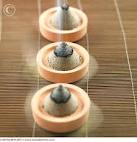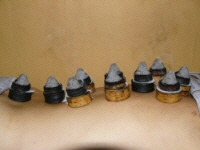solitude
Healthy Body, Beautiful Mind, and Balanced Young Life !
Eastern Medicine
Call Today for Consultation
Telephone: 760. 754. 2007
Business Hours: Mon-Fri 9am-6pm, Sat 9am-12pm
Moxibustion
 Moxibustion is a traditional Eastern medicine technique that involves the burning of mugwort, a small, spongy herb, to facilitate healing. Moxibustion has been used throughout Asia for thousands of years; in fact, the actual Chinese character for acupuncture, translated literally, means "acupuncture-moxibustion." The purpose of moxibustion, as with most forms of traditional Eastern medicine, is to strengthen the blood, stimulate the flow of qi, and maintain general health.
Moxibustion is a traditional Eastern medicine technique that involves the burning of mugwort, a small, spongy herb, to facilitate healing. Moxibustion has been used throughout Asia for thousands of years; in fact, the actual Chinese character for acupuncture, translated literally, means "acupuncture-moxibustion." The purpose of moxibustion, as with most forms of traditional Eastern medicine, is to strengthen the blood, stimulate the flow of qi, and maintain general health.
There are two types of moxibustion: direct and indirect. In direct moxibustion, a small, cone-shaped amount of moxa is placed on top of an acupuncture point and burned. This type of moxibustion is further categorized into two types: scarring and non-scarring. With scarring moxibustion, the moxa is placed on a point, ignited, and allowed to remain onto the point until it burns out completely. This may lead to localized scarring, blisters and scarring after healing. With non-scarring moxibustion, the moxa is placed on the point and lit, but is extinguished or removed before it burns the skin. The patient will experience a pleasant heating sensation that penetrates deep into the skin, but should not experience any pain, blistering or scarring unless the moxa is left in place for too long.
Indirect moxibustion is currently the more popular form of care because there is a much lower risk of pain or burning. In indirect moxibustion, a practitioner lights one end of a moxa stick, roughly the shape and size of a cigar, and holds it close to the area being treated for several minutes until the area turns red. Another form of indirect moxibustion uses both acupuncture needles and moxa. A needle is inserted into an acupoint and retained. The tip of the needle is then wrapped in moxa and ignited, generating heat to the point and the surrounding area. After the desired effect is achieved, the moxa is extinguished and the needle(s) removed.
 In traditional Eastern medicine, moxibustion is used on people who have a cold or stagnant condition. The burning of moxa is believed to expel cold and warm the meridians, which leads to smoother flow of blood and qi. In Western medicine, moxibustion has successfully been used to turn breech babies into a normal head-down position prior to childbirth. A landmark study published in the Journal of the American Medical Association in 1998 found that up to 75% of women suffering from breech presentations before childbirth had fetuses that rotated to the normal position after receiving moxibustion at an acupuncture point on the Bladder meridian. Other studies have shown that moxibustion increases the movement of the fetus in pregnant women, and may reduce the symptoms of menstrual cramps when used in conjunction with traditional acupuncture.
In traditional Eastern medicine, moxibustion is used on people who have a cold or stagnant condition. The burning of moxa is believed to expel cold and warm the meridians, which leads to smoother flow of blood and qi. In Western medicine, moxibustion has successfully been used to turn breech babies into a normal head-down position prior to childbirth. A landmark study published in the Journal of the American Medical Association in 1998 found that up to 75% of women suffering from breech presentations before childbirth had fetuses that rotated to the normal position after receiving moxibustion at an acupuncture point on the Bladder meridian. Other studies have shown that moxibustion increases the movement of the fetus in pregnant women, and may reduce the symptoms of menstrual cramps when used in conjunction with traditional acupuncture.
Mugwort, also known as artemesia vulgaris or ai ye in Chinese, has a long history of use in folk medicine. Research has shown that it acts as an emmenagogue that is, an agent that increases blood circulation to the pelvic area and uterus and stimulates menstruation. This could explain its use in treating breech births and menstrual cramps.
Oceanside Clinic: 1906 Oceanside Blvd., Suite S, Oceanside, CA 92054 T. 760. 754. 2007